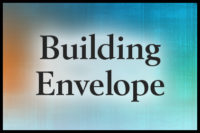Building envelope commissioning ensures long-term performance of a building’s most critical and liability-prone components. A general contractor could, conceivably, resist this process on the assumption that it creates more work, impacts the schedule and increases cost. However, while these may be true, the advantages significantly outweigh the costs and greatly benefit the GC, all which will be examined throughout this article.
The NIBS Guideline 3-2012: Building Enclosure Commissioning Process identifies building enclosure performance as a team sport that needs to be carefully planned and monitored from the project’s beginning and at each step of the building process. It offers the owner and the owners’ design representatives a framework to manage the processes that facilitate the successful performance of the building enclosure. [1]
The guideline refines performance objectives for control of moisture, condensation, heat flow, air flow, water vapor flow, noise, fire, vibrations, energy migration, light, infrared radiation, ultraviolet radiation, structural performance, durability, resiliency, security, reliability, aesthetics, value, constructability, maintainability and sustainability.
It’s important to remember, however, that commissioning objectives for any given building’s enclosure can vary by the type of owner, occupancy, use, size and specific project requirements.
Purpose of BEC
Commissioning is fundamental to the success of the whole-building design process. BEC is critical to ensuring that the building envelope performs as intended and meets the established performance criteria by providing the desired thermal properties and resisting air and water migration. In other words, is the building going to perform in real life as it does on paper?
The objectives of the commissioning process are driven by several factors, including building type, expected life cycles, geographic location, various environmental conditions, climatic considerations, desired energy efficiency, acoustical requirements, and budgetary constraints, which all may vary considerably between projects.
Ensuring that the building meets the Owner’s Project Requirements is one of the key objectives in BEC. Outlining the OPR is typically developed in the pre-design phase of a project to assist the team with understanding the owner’s objectives and criteria for the project. The OPR forms the basis from which all design, construction, acceptance, and operation decisions are made.
Benefits of BEC
Building enclosure-related owner project requirements are clearly established and conveyed through each project phase;
A single-source reference for many performance testing requirements simplifies the specification writing;
Better planning and proactive design considerations in the pre-design and design phases reduce confusion, or requests for information, change orders, and improper or inadequate deliverables in the construction phase; [2]
Contribute toward LEED certification: two points can be earned, under LEED v4, for enhanced envelope commissioning, which will likely increase owners’ demand for BEC.
Performs as Designed
BEC involves the flow of heat, air and moisture across all six sides of the building enclosure—the walls, roof and slab. In greater detail, BEC addresses performance objectives for the exterior enclosure including the control of heat flow, air flow, noise, fire, light, infrared, ultraviolet, rain penetration, moisture, structural performance, durability, security, reliability, aesthetics, value, constructability, maintainability, and sustainability.
The building enclosure is significantly influenced by its environment. Therefore, maintaining an awareness of potential problems with roof and wall components during design and construction is far better than dealing with water and air leakage-related issues once the building is occupied. Water infiltration and condensation related issues are far and away the greatest basis for construction litigation in the U.S.
BEC Process—ASTM E2813
The American Society for Testing and Materials (ASTM) E2813, Standard Practice for Building Enclosure Commissioning, outlines minimum requirements from the NIBS Guideline 3 process.
The ASTM E2813 Annex A1, “OPR Development Guideline,” outlines the establishment of owners’ requirements in regards to energy, environment, safety and security, durability, sustainability and operation. ASTM E2813 establishes two levels of building enclosure commissioning: fundamental and enhanced.
In fundamental BECs:
- The BEC agent becomes involved in the project no later than the design-development phase;
- Preliminary OPR is reviewed and documented;
- There is a single design review of enclosure-related drawings and specifications;
- A limited number of lab and field performance tests are required.
In enhanced BECs:
- The BEC agent is involved in the project no later than the commencement of the schematic design phase;
- Technical assistance and documentation are provided for development of preliminary OPR;
- At least three design reviews of enclosure-related drawings and specifications are accomplished;
- Additional lab and field performance tests are conducted beyond those in the fundamental process.
Establish OPR
There are many considerations when it comes to OPR, including energy consumption, environment, safety and security, durability and operation. Design elements of the building enclosure have become much more complex over the years with new and improved materials, a better understanding of how enclosures perform, updated codes and mandates, building information modeling, and additional project delivery method, for example. Each of these aspects has an impact on the other, which results in a more complex project process and how a project unfolds.
Start with the Design
The value of the process is truly maximized when envelope commissioning begins in design, with at least one full review of the design documents. Preferably, the GC will be brought into the BEC process during the design phase with the focus on continuity for air and water tightness, potential points of failure, and constructability. From a GC perspective, ideally, the earlier they are involved with BEC, the better. Design-Build projects lend themselves to early GC involvement more than Design-Bid-Build projects.
The GC and key subcontractors, often in design assist roles, are in a unique position to contribute their expertise and practical experience to ensure interface details are constructible and effective. Collaboration in design not only ensues in better detailing, it results in buy-in from the GC and the subs because they are invested in the process. This involvement encourages clearly defined roles and responsibilities. It also ensures accountability between the stakeholders and a deeper, more communicative relationship between everyone.
Shop Drawing Review
This entails reviewing the building envelope system submittals for general conformance with the construction drawings and specifications. This is also the time to examine and coordinate shop drawing details at which various envelope components interface. These review meetings reduce the number of submittal rejections and include architect, owner, envelope consultant, GC, and sub trades.
Laboratory Performance Mock-Up (PMU)
Arguably, no other element of the BEC process directly benefits the GC more than the construction and testing of the building envelope performance mock up. The PMU process results in the validation of the design, identifies constructability issues and sets standards for workmanship. If properly scheduled, the PMU process allows adjustments to be made, based on lessons learned, that can be incorporated into the actual construction.
While not every condition can be included on the PMU, it is important to incorporate all typical details, critical interfaces and high risk conditions. For the results of the PMU testing to be meaningful, non-project conditions should be avoided as much as possible.
The testing program must be project specific, designed to verify the owner’s project requirements, and best simulate the anticipated environmental conditions at the project location. A typical PMU testing program will include tests for air infiltration, static and dynamic water infiltration, structural wind loads and live load deflection. Other tests that may be performed depending on the location and the nature of the project are thermal movement, condensation resistance and seismic movement. The loads for each test are project specific and should be consistent with building codes and the specified project performance requirements. Without comprehensive and customized performance testing, it is impossible to confirm that performance criteria outlined in the OPR has been satisfied.
Construction
Once a project is into construction, the process turns towards verification that the design intent is met for envelope components. Pre-installation conferences are among some of the most valuable mechanisms in the BEC and should be conducted for each definable area of work on the enclosure. Ideally, the GC acts as the facilitator of the conference, while the trade contractor’s role is to articulate to the rest of the BEC team that they have a clear understanding of their work and how it will be accomplished in compliance with the project requirements. If conducted in this manner, the trade contractor is an invested stakeholder prior to starting the work and the other stakeholders will be confident in their ability to prosecute the work.
Other important components during the construction phase are:
- Field inspections to verify correct installation of the exterior enclosure systems and tracking issues to resolution. These inspections should be based on project specific checklists and should be thoroughly documented.
- Field testing of the building envelope for potential water and air intrusion. A testing matrix should be developed prior to beginning construction on the enclosure. It should define what tests are to be performed, at what point they are to be performed and at what frequency. It is also important to establish the procedure to be followed in the event of a failed test.
- Verification of warranties, training and maintenance manuals.
BEC in Action
The Los Angeles Federal Courthouse, currently under construction, is an excellent example of effective BEC. Design firm Skidmore, Owings & Merrill worked together with trade contractors and the GC to develop interface details that meet performance criteria, are constructible and in which all team members are invested. Additionally, the GC, SOM, building envelope consultant SGH and the owner’s commissioning agent, Jacobs Engineering, collaborated to create an extensive field testing program, ensuring that the project meets OPR and performs as anticipated.
1. “Updated NIBS Guideline 3 Will Help Owners Get the Building Enclosure Performance They Expect,” NIBS.org, June 7, 2012.
2. http://facilityexecutive.com/2015/03/building-envelope-commissioning/ (accessed July 24, 2015).




